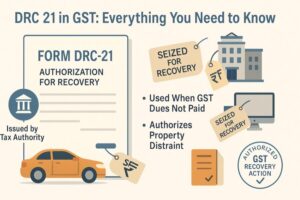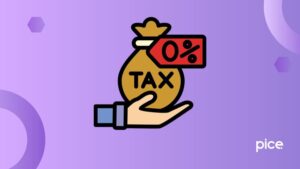Effect of GST on Service Sector in India
- 30 Jun 25
- 12 mins

Effect of GST on Service Sector in India
- How Does GST Work in the Service Sector?
- What are the Benefits of GST on Service Providers?
- What is the Impact of GST on Trade, Manufacturing, and Service?
- Is GST Mandatory for the Service Sector?
- What is the GST Limit for the Service Sector?
- Who Will Pay GST for Services?
- What are the Common Challenges Faced by Service Providers Under GST?
- Conclusion
Key Takeaways
- GST is destination-based, taxing services at the consumer's location, not the provider's.
- Input Tax Credit (ITC) helps service providers lower their tax liability on business inputs.
- Multiple GST slabs (0% to 28%) apply based on service type, simplifying tax classification.
- GST registration is mandatory for service providers above ₹40L/₹20L turnover, optional below.
- Digital compliance is smoother, but small businesses still face tech and ITC-related challenges.
India's transition to the Goods and Services Tax (GST) marked one of the most ambitious tax reforms in its economic history, redefining the landscape for manufacturers and service providers. By replacing a complex web of indirect taxes with a unified system, GST aimed to bring transparency, ease of business, and seamless interstate trade.
But behind the promise of simplification lies a spectrum of sector-specific impacts. While manufacturing saw shifts in cost structures and supply chains, the service industry grappled with new compliance protocols. This article focuses on understanding the effect of GST on the service sector and other related aspects.
How Does GST Work in the Service Sector?
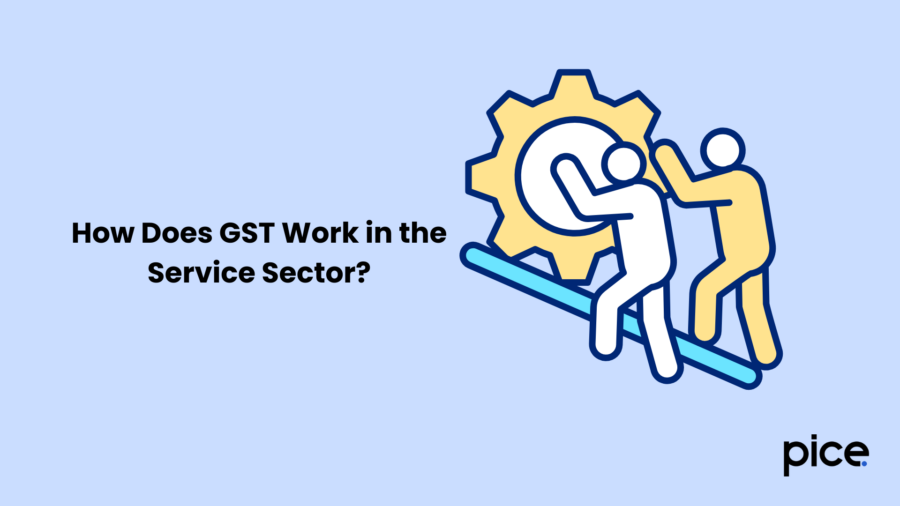
Besides GDP domination, the service sector's contribution to attracting foreign investments is non-negotiable. It widely covers activities related to trading, transport, hotels, restaurant services, insurance, and services associated with construction and community.
Besides exporting, the service sector provides large-scale employment worldwide. Currently, the GST threshold amount for service providers is Rs. 40 Lakhs for normal category states and Rs. 20 Lakhs for special category states.
Let us discuss the effect of GST on the service sector in the following section:
1. Destination-Based Taxation
GST's destination-based approach mainly creates the cornerstone of the service sector. Earlier, taxes were applied at its production point, whereas now, GST is levied at the location of the service receiver.
Presently running service economies promote remote access to intangible services, and service providers understand that the tax burden lies with the end consumer's location.
2. Input Tax Credit (ITC) in Services
The provision of Input Tax Credit (ITC) has allowed service providers to counterbalance taxes and reduce their tax burden. Utilising ITC, they enjoy the opportunity of offsetting the amount they paid as input, going beyond their tax liability.
For example, when a service provider purchases goods or services for the purpose of their businesses, they can deduct that amount from the final tax amount they are supposed to pay. This encourages more investments in quality inputs and financial thrift.
3. Tax Slabs for Services
GST implementation has created different tax slabs depending on the values of various types of services, making GST a noteworthy effect on the service sector. This has led to a customised taxation system as follows:
| Type of Tax Slab | Type of Service | Example |
| 28% GST | Ancillary services, Luxury products | High-end automobiles, AC, Fridges, perfumes, cigarettes |
| 18% GST | Telecom services, Hotel and restaurant services, Legal services, security services, higher education | Computers, legal advisory, consulting, Banking, college and university fees |
| 12% GST | Standard rate for daily products and services | Mobiles, fruits, ghee |
| 5% GST | Smaller Hotel and restaurant services, Transport services | Budget Hotels, Logistics, railways and air transports, coals |
| 3% GST | Jewellery | Diamond, Silver, Gold |
| 0.25% GST | Unfinished Precious or semi-precious stones, Non-industrial diamonds, synthetic stones | Sapphire. Emerald, |
| 0% GST | Educational services, daily essentials | Fresh vegetables, healthcare, milk, eggs, preschool and primary education |
4. Exemptions and Composition Scheme
Some small business service providers choose exemption and composition schemes to simplify tax compliance for their businesses. Eligible taxpayers can choose this scheme voluntarily. Under this scheme, instead of regular GST, business owners have to pay a fixed percentage of their annual profit.
Usually, businesses with a threshold limit of 1.5 crores can opt for this type of scheme to lessen their tax compliance burden. The drawbacks of these schemes include no authority to ask for taxes from customers and non-eligibility to claim input tax credits.
5. Reverse Charge Mechanism (RCM)
A reverse Charge Mechanism is where a recipient of goods and services pays service tax instead of the supplier of the services. This way, the service recipient pays taxes to the Government. Usually, B2B services, such as services received from foreign suppliers, sponsorship services, and good transport agencies (GTA), apply to RCM.
For example, an ABC company buys coffee beans worth Rs. 20,000 from an unauthorised farmer. Since the farmer does not charge GST on the product, the ABC company pays 5% GST to the Government following RCM.
6. E-Invoicing and Compliance
E-invoicing and GST compliance could be considered a significant effect of GST on the service sector. As a result of this digital transition, the compliance complexity for businesses has reduced significantly. For example, business owners do not have the burden of paperwork. In addition, tax return filing, calculation, and registration have become streamlined and error-free.
What are the Benefits of GST on Service Providers?
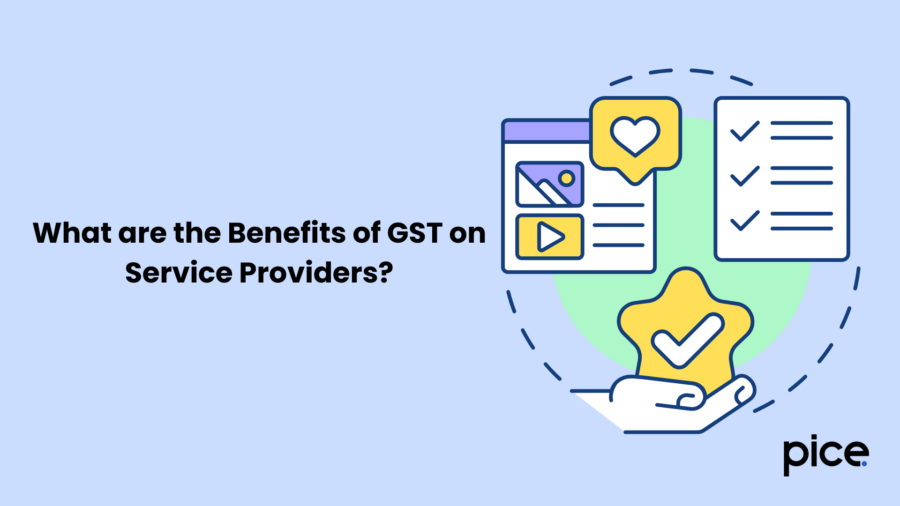
GST, goods and services tax applicability and its benefits for service providers are essential to navigate since this will help understand the entire supply chain and enable the business to be done effectively.
Let us talk about the benefits of GST on service providers:
- Input Tax Credit (ITC)
The availability of Input Tax Credits is a significant effect of GST on the service sector. Businesses have the opportunity to offset the tax amount paid while purchasing business-related products, reducing their tax liability paid on inputs.
- Streamlined Tax Structure
Complex transactions most often take place within the service sectors. The current GST regime unifies indirect taxes that were prevailing earlier under a single umbrella.
For example, the Krishi Kalyan Cess (KKC) was introduced in 2016 to improve farmer welfare and agriculture. As per this Cess, 0.5% of tax was levied as service tax. However, it was abolished after the GST reform in 2017. GST reform has reduced the indirect tax burden multiplefold.
- Decreasing the Cascading Effect of Indirect Taxes
The pre-GST era was struggling with double taxation, meaning taxes were levied on top of existing taxed components. This process was called the cascading effect, which led to increased product prices.
GST has reduced this double taxation by ensuring businesses are taxed only once during every service delivery or production stage. The decreased cascading effect has led to transparency and fairness, and it has also eliminated the potential for inflation.
- Expanded Tax Base
Another remarkable effect of GST on the service sector is the consistent increase in the number of service providers. It has expanded the tax base and contributed to the Government's revenue collection.
What is the Impact of GST on Trade, Manufacturing, and Service?
The introduction of GST and its effect on the service sector have been revolutionary. Let us now shed some light on the impact of GST on trade, manufacturing and service in the following section:
Here is the impact of GST on the trade sector:
- Transparency in the supply chain
GST implementation has brought transparency within the supply chain through centralised registration and a unified tax system. It has enabled real-time tracking of goods. In addition, traders can easily apply for tax returns using digital platforms in minutes.
- The lesser burden on tax compliance
In the pre-GST era, traders were bound to pay taxes for different stages of the supply chain. However, the simplified tax structure of GST has decreased the taxation complexities. As a result, traders can focus on their core operations and feel less of a compliance burden.
- Dismantling of interstate barriers
Before GST, several indirect taxes were involved during product movements across states. The centralised trade registration under the GST regime has reduced the number of checkpoints and increased the speed of product movement. This has resulted in lower transportation charges and advanced competitiveness among traders.
The following are the impacts of GST on the manufacturing sector:
- Relief from the Cascading Effect
The term cascading effect refers to "tax levied upon tax." When the cascading effect occurs, a tax is levied on every step of the product sale. The current GST regime has eliminated the cascading effect of taxes by adding value to every step of a product's manufacturing. This has resulted in inflation prevention and fairness promotion.
- Tax Harmonisation
GST has divided the nature of all services into different tax slabs. The GST slab rates range from 0% to 28%. Each category of goods and services is designated with a specific percentage to ensure a balanced tax system. This leads to uniform opportunities for manufacturers across states.
- Advantages of ITC
Another effect of GST implementation is the input tax credit, which has been beneficial for manufacturers since it enables them to counterbalance already paid taxes on raw materials. They can claim the ITC to save costs, so the overall tax burden of manufacturers goes down significantly.
Here are the impact of GST on the service sector:
- Promotion of Digital Economy
The promotion of the digital economy through digital record keeping, registration, invoicing, and filing directly affects GST in the service sector. Service providers have a comprehensive understanding of the simplified taxation system that only takes minutes to complete. This system not only increases efficiency but also reduces the possibilities of tax evasion and penalties.
- Standardised Taxation System
The diversified service sector often struggles with multiple taxes for different services. However, the standardised taxation system promoted by GST offers a common ground for everyone, leading to a transparent and consistent taxation framework.
- Consistent Economic Growth
With GST, service providers can formalise their operations more accountable and transparently, leading to consistent economic growth.
Therefore, a good and service tax could be considered a catalyst for progress since it has made doing business extremely easy for traders, manufacturers, and service providers.
Is GST Mandatory for the Service Sector?
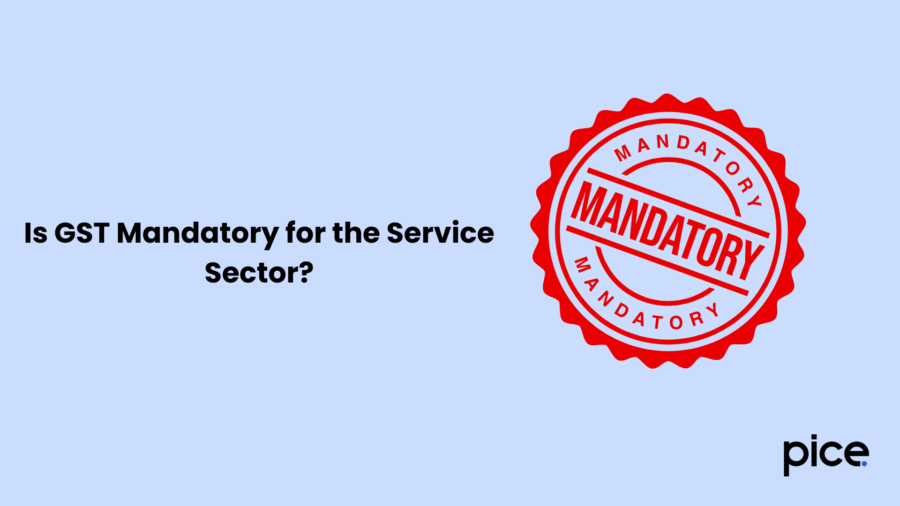
Yes, GST is mandatory for the service sector. According to the new GST Act, businesses with an annual turnover exceeding Rs. 40 Lakhs for normal category states and Rs. 20 Lakhs for special category states must register under the GST regime.
Considering the effect of GST on the service sector, GST registration is not only an obligation but could also be an opportunity. It helps reduce the tax burden, simplify the taxation system, and eliminate the cascading effect of other indirect taxes.
In addition, service providers who voluntarily register for GST can obtain the benefits of Input Tax Credits.
What is the GST Limit for the Service Sector?
The Government changes the GST threshold limit annually. According to the latest GST Act update, service providers belonging to normal category states with an annual turnover of Rs. 40 Lakhs and more must register for GST.
Those with lesser turnover amounts have the authority to register for GST voluntarily. If they do, they will enjoy the benefits of the Government's input tax credit as a result of GST on the service sector.
Who Will Pay GST for Services?
Usually, service providers are responsible for paying GST. They collect tax from customers, file regular GST returns, and finally remit the collected tax amount to the Government. They must maintain a proper record and adhere to the regulated timeline. Otherwise, it might lead to penalties.
What are the Common Challenges Faced by Service Providers Under GST?

The effect of GST on the service sector is not always positive. Here are some of the common challenges faced by service providers under GST:
- Higher Compliance Costs
One of the main challenges service sectors face from GST is its higher compliance cost. This has led to higher prices for software products and services.
- Adoption of Technology
Small businesses and rural businesses sometimes struggle with the digital processes of return filing, record-keeping and registration.
- Challenges in Classification
Understanding different tax slabs and categorising a particular product or service within that slab sometimes seems challenging. A specific service that does not align with the regulated GST framework can lead to disputes.
- Challenges in Obtaining ITC
Many times, service providers struggle with understanding the rules of the Input Tax Credit, and small traders find challenges in managing the ITC.
- Fluctuating Tax Rates
The GST tax amount keeps fluctuating, leading to complications in pricing. It becomes hard to keep track of the accurate GST rate of a particular product or service.
Conclusion
So, to conclude, the effect of GST on the service sector, trading sector and manufacturing sector has been quite beneficial and significant. The streamlined cash flow, elimination of the cascading effect of taxes, and reduced compliance with tax burdens make it a convenient tool.
This simplified taxation system has not only increased efficiency and transparency in the supply chain but has also highly contributed to the growth of the country's economy.
💡If you want to streamline your invoices and make payments via credit or debit card or UPI, consider using the PICE App. Explore the PICE App today and take your business to new heights.
 By
By 





